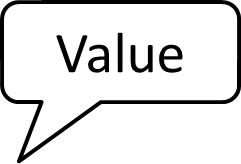Communicating the Customer Value Created is Key 5 in a Sales Leader’s Guide to Selling Value
Welcome to our final installment of A Sales Leader’s Guide to Selling Value blog series which talks about communicating the customer value created. This blog series is for sales leaders and focuses on how to execute a value creation selling approach. We have already created value for the customer by understanding the customer’s business and solving the customer’s challenges. We have also already set ourselves up to win the business by differentiating the value of our advantages from the competition and by quantifying the value created. All that is left to do now is effectively communicate the value that will be created.
Communicating the customer value
Communication in general is a difficult skill that sales people must master regardless of the selling approach. Communicating value is probably the most difficult part of executing a value creation selling approach. The challenge for most sales people in communicating value is that it’s a much different conversation than many typically have with their customers and prospects.
Typically, sales people are comfortable talking about their solutions, benefits, specifications and how the solution is used. Having a conversation about how the solution makes or saves the customer’s business money is a much more difficult task. Fortunately, it doesn’t have to be. The trick to communicating the value created is putting the information we have developed in the first four keys into a communication framework.
3 types of communication
When we are communicating value, we teach 3 types of communication:
- The Value Statement – A 1 to 2 minute positioning message that communicates your value as a supplier to the customer. This type of communication is best for a 1 on 1 audience and time is very limited.
- The Value Discussion – A longer presentation meant for groups of 2 to 3 where the sales rep uses a whiteboard to have a two-way dialogue with the customer about the value created.
- The Value Presentation – A form of a traditional 30 minute plus PowerPoint presentation to a larger customer audience.
Framework for Communicating Value
We find that focusing on a core set of content and tailoring that content based on the audience and time available produces excellent results. The framework that we often use with customers is as follows:
Step 1:
Begin by discussing your understanding of the customer’s business. Highlight the customer’s influences, their initiatives and their value priorities (as you know them up to this point). This shows the customer that you understand where their priorities come from. It also shows that you care about helping the customer achieve what is most important. Customers appreciate this type of empathy – and rarely receive it from a seller.
Step 2:
Transition into a discussion about the challenges preventing the customer from achieving their desired future state. This shows that you are knowledgeable about the customer’s business and establishes that a change will need to be made to reach the desired future state.
Step 3:
Now it is time to discuss the solution you are proposing to solve the customer’s challenges. Show the customer that you aren’t just proposing a solution you think will be a good fit for them. The solution you proposes addresses an issue preventing them from getting to their desired future state is very important.
Step 4:
Transition from here to a discussion about the differences of your solution and the quantified value they create for the customer. Discuss with the customer the impact your solution(s) will make and build a sense of urgency for acting now.
Step 5:
Establish next steps. Establishing the next steps should always be done before concluding any communication with the customer, whether it be a value conversation or not. Come to the meeting or call with suggestions for next steps because this can help the customer.
Follow this process for communicating value created and follow our other 4 keys to executing a value creation selling approach and you will be building mutually beneficial value for you and your customers in no time.

